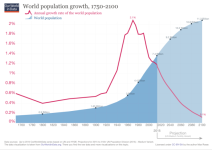SimpleDon
Veteran Member
<snip>
A lot of that increase is due to increased life expectancies alone, though. If you run the calculations with my parameters and simplifications and a fertility rate exactly at the replacement level, that is population growth rate 0.0%, you still get a ratio of 1.6 exactly. In that model, each one-year-cohort is exactly as strong as the previous one, so all we need to do is compare the 40 cohorts between ages 25-65 to the 25 cohorts 65-90. A more realistic age-dependent mortality, instead of pretending everyone drops dead on their 90th birthday, only makes things worse, though not by much as long as few people die before 65.
Indeed, even if we plug in the US's current population growth rate of 0.7% annually, the ratio is still 2.01 workers to every retiree at a 90 year life expectancy. In order to maintain a ratio of 2.9 with a life expectancy of 90 years, a growth rate of 1.8% annually is required. Conversely, if you believe that life expectancies will plateau at 80 or 85, even the declining population corresponding to a fertility rate of 1.5 will still have a workers/retirees ratio of 1.98 or 1.44 respectively.
What these calculations also ignore is that not only are the retiree cohorts numerically stronger in a declining population than the working-age cohorts, but the cohorts of children and students are weaker than the working age cohorts. These effects almost cancel each other out: If we assume a stable fertility rate high enough to guarantee an annual population growth of 1% and life expectancy of 90 years, the ratio of workers/non-workers (where non-workers include both retirees and children and full-time students, modeled as anyone below age 25 or above 65) will be 0.7629. For population declining at -1.1% annually (which is what I get for TFR of 1.5) that same figure will be 0.7547. In fact those ratios are symmetric: A positive growth rate of +1% or 101/100 produces the exact same ratio as a negative growth rate of -0.99% (=100/101), and the optimal ratio of 0.8 (40 cohorts of working age people to 25 cohorts each of children/students and retirees) is achieved only at 0.0 growth, where all cohorts are the same size. This is an artifact of the fact that our pre- and post-productive life phases are the same length (25 years before 25, 25 years after 65 till death at 90). With a lower life expectancy, children and students will be more of a burden than retirees and thus the ratio worse under a growing than a declining population.
And we could improve this ratio by increasing immigration of young workers. This is my argument.
We could. Or we could reap the fruits of productivity increases and realise that in the 21st century there's no longer any good reason why the ratio has to be high to provide everyone with a good life.
The birth rate is the running average number of children each woman has in their lifetime. The replacement rate is the birth rate required to keep the population constant without any migration or immigration, people leaving or entering the country. The replacement has to be above two to account for the factors you mentioned but it must always be above two.
No, the birth rate is the number of children born per year per 1000 inhabitants. What you're talking about is the total fertility rate.
Terminology aside, the replacement fertility rate can be below 2.00 under one condition: If more girls than boys are born, and the bias is strong enough to offset girls' and women's death rate before the end of fertility.
<snip>
If so, I don't see how what you're proposing - to keep the ratio artificially high in order to not have to address those priorities - is any different from a man who keeps throwing more and more fuel into the fireplace to fight the chill while ignoring the open windows.
<snip>
Okay, more. Yes, the birth rate and the fertility rate are different. I tried to keep talking about the much more relevant fertility rate to the discussion but kept slipping back to the term birth rate the term that you and bomb were using. The fertility rate is the rate of births among women of childbearing age. This is the critical question here. And yes, the birth rate can drop below 2.0 because 90 year old women don't have many births.
Yes, automation has the potentional for bettering the lives of the vast majority of the population, just as it did up until the time of neoliberalism when the gains from automation was directed by the neoliberal policies to the 1%. It still has the possibilities to improve the lives of the vast majority of the people but only if the neoliberal economic policies are changed. I didn't propose anything in my post but to say that all things being equal, meaning that the policies won't change, that the 1% won't suddenly desire less income, that the 1% won't let their grip on the political process go, that the conservatives in the country won't realize that the 1% are taking advantage of the conservatives' gullibility to economically disadvantage the 99%, that the conservatives will suddenly not require daily affirmation of the lies that they are being told, etc. I don't see any reason to believe any of these things, if anything they are getting worse, Trumpism for example.
If I was proposing anything it would be that we return to the days in which the conservatives were being ignored because their contribution to any question involving change is always "no" and the solutions to the problems that we have almost always involve changes. Changes involve risk and if you aren't being affected or you don't realize that you are being affected by the problems it is easy to say "no".
But rather than ignoring conservatives the opposite has happened. More and more people take the easy way and the country has become more conservative, not less. They are told that the way to better a better life is for the country to become more individualistic, people watching out for themselves and that we haven't gained or that we have stopped gaining from collective actions and watching out for each other and cooperating with each other. This is utter crap. We are were we are today because of collective, not individual actions. Each innovation and discovery builds on the previous ones. As the complexity increases the need for collaborative action increase.
I am not assuming that you are either a neoliberal or a conservative or a Malthusian or a xenophobe. I don't know you, I don't remember any other posts that you have contributed here. This is not unusual for me, I don't have many people categorized as to their beliefs, it would probably destroy the happy illusion I have that the vast majority of people are moderates, even if they don't realize it. I am just trying to answer your post, which is an attempt to clarify bomb's post. Which you did quite well, he and I were talking past one another.











